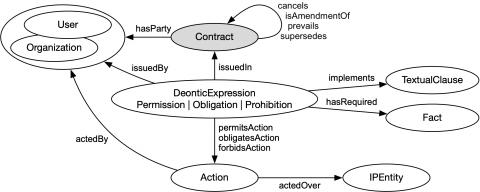
by Philip Merrill
Many enjoy not following the ins and outs of intellectual property law however MPEG's Intellectual Property Rights Ontologies group has taken it on as a mechanical challenge. The context includes a growing collection of MPEG-21 related work, and the upshot is that this bridges the gap between machine-readable binary logic and the sort of contracts media companies engage in using human, legal language. Such language includes multiple national laws and regulations, exceptions, as well as segments excerpted from larger works.
There are various systems in place for agents in the media space to get assistance managing their rights. Digital rights management companies rely on some international standards but do not have such a standard designed for computers and networked users to organize clients' information. Online transactions for media permissions are commonplace but inevitably for now such activity tends to occur in silos or else with regional limits on interoperability. The IPR Ontologies have been slow-ripening but they embody a great deal of what is needed to move contractual actions negotiating permissions and obligations into a new online marketplace. Having the law and the metadata correlate is the sort of efficiency that blockchain ledgers can help leverage. Extensive marketplace contracting could be made transparent and searchable as a result of being mechanized.
What makes such a system useful is the ability to make changes to it, so that an extensive base of data can be dynamically updated. In that sense you could say there are two levels of permissions, those described within the IPR Ontologies' IP entities and those pertaining to the users who are authorized to engage interactively with the entities as well as presumably with some associated content. This is important because actions, users and IP entities are considered the three main entities of IPR Ontologies. This is because of users' key role as empowered updaters, also known as people engaged in life in the real world.
An important feature of the IP entities is the maturity of the 2020 state-of-the-art for describing them. Related work in MPEG-7 and MPEG-21 goes back a generation (or more) and now assures infrastructural technology is in place. Many full-fledged, compliant systems have been created and are operating based on -7 and -21 standards work. IPR Ontologies has a unique new place, is positioned to receive robust support within the MPEG ecosystem.
Two fun words in MPEG's literature in the IPR Ontologies group’s work are "deontic" and "alethic," which make handy capsules for the thoughts or "philosophy" behind each. Deontic pertains both to permissions and future obligations (prohibitions too). Many remember learning rules set by parents or teachers. The point usually made when such rules are explained is that life can proceed, business can proceed, provided those exact rules are met. Pertaining to exactitude, the "alethic" side of life is composed of values based on Aristotle. Binary values, such as true or false, and most specifically the true/false binary value itself compose the alethic base of acceptable statements. This certainly goes back to the supporting infrastructure issues, from MPEG-7 and -21, because mechanical computing exploits this alethic structure and its binary ways.
For the details of the IPR Ontologies themselves, the very definiteness of the alethic format is what can become so problematic when dealing with rules set by “law”, laws, rules, “regulations”, and policy statements. Human language utterances can seem designed to defeat any effort to make them definite, which is why years of litigation are continuously spent resolving the meaning of phrases used in contracts. The MPEG ecosystem, however, is designed to automate and mechanize certain contracts so that for example, technology needed for a blockchain application is ready and waiting in the toolkit. Earlier investigations of intellectual property marked out value chains in the digital media marketplace. Some of these pieces live on in the IP Ontologies' designations for user roles as well as its specifics for audio. Due to the use of excerpts through sampling, recorded audio can all be considered designed to travel downstream from its initial creator. The importance of snippets is still socially novel but online social engagement proves big attention gets focused on the brief. Licensing for complete works as well as excerpted snippets is just the sort of marketplace that IPR Ontologies will now support in an extensible way.
There have been many relevant social developments over the past generation. Going back, one can remember when the Digital Object Identifier system was new (1997) or when the HathiTrust partnership formed to manage millions of scanned books (2008). Since the United States' passage of the Music Modernization Act of 2018, "The Mechanical Licensing Collective" has been formed pursuant to it and is expected to begin issuing blanket mechanical licenses over the internet at the beginning of next year. Their use of the word "mechanical" has a specific legal meaning, licensing the underlying musical composition itself. But there is more than a little ambiguity in the larger phrase because this is a massive automated-rights application. Set against such background developments, MPEG's developing standard on IPR Ontologies based smart contracts is more than timely.
May 2020
